Literature Review: Innovative Accounting in Australian Banking
VerifiedAdded on 2023/03/20
|7
|1913
|53
Literature Review
AI Summary
This literature review explores the significant impact of innovative, technology-based accounting systems on the Australian banking industry. The analysis, based on various academic articles, highlights the shift from manual to digital accounting processes, emphasizing the adoption of software like SISA, MYOB, and XERO by major banks. The review details how these technological advancements have streamlined data recording, improved efficiency, and enhanced competitiveness, leading to better customer service, more informed decision-making, and compliance with international accounting standards. Specific areas such as loan accounting applications, general ledger systems, and the consolidation of financial reporting are examined to illustrate how technology contributes to the success of Australian banking, making it one of the safest and most profitable in the world. The review concludes that technology-based accounting systems are vital for the industry's global integration and success.
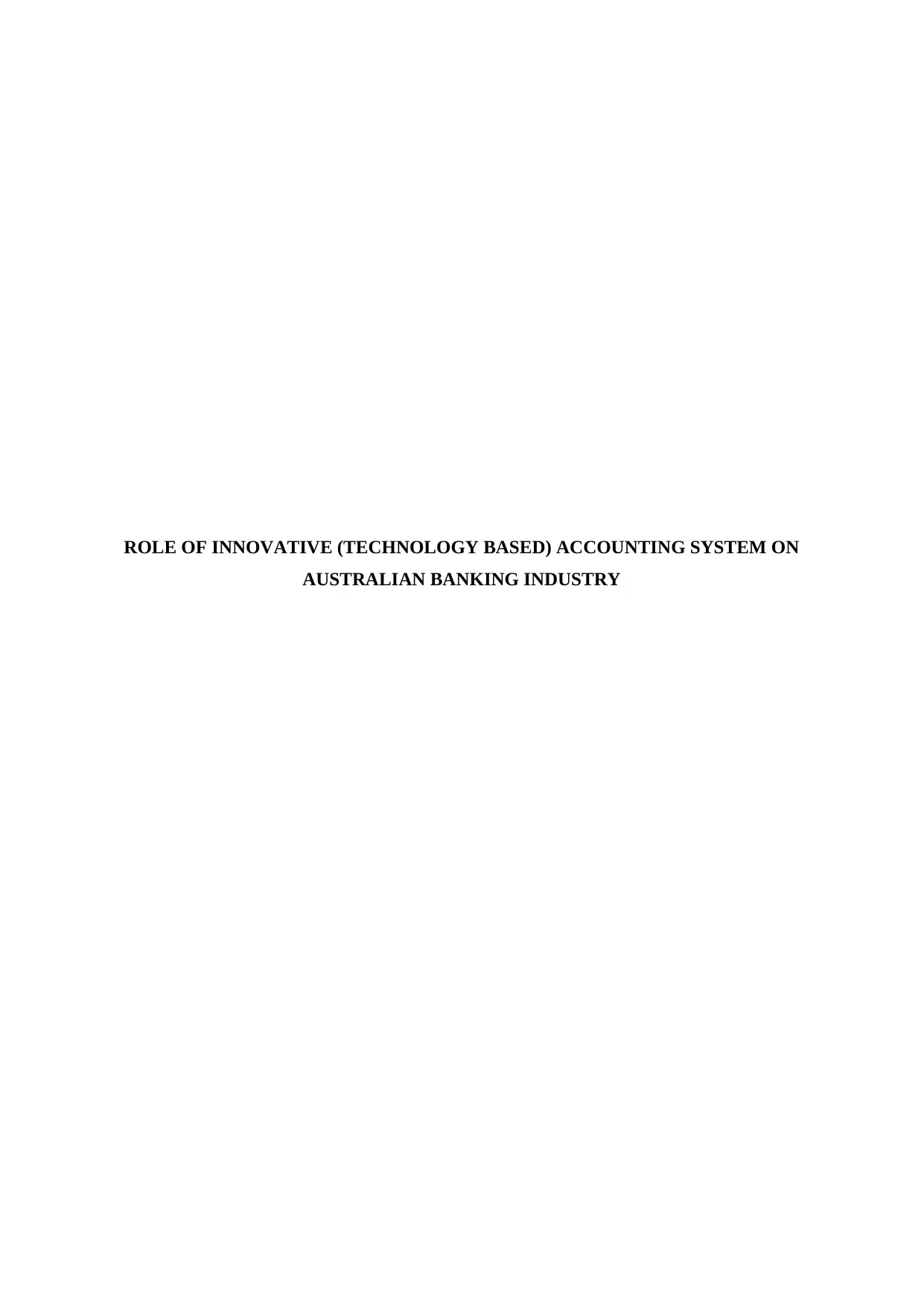
ROLE OF INNOVATIVE (TECHNOLOGY BASED) ACCOUNTING SYSTEM ON
AUSTRALIAN BANKING INDUSTRY
AUSTRALIAN BANKING INDUSTRY
Paraphrase This Document
Need a fresh take? Get an instant paraphrase of this document with our AI Paraphraser
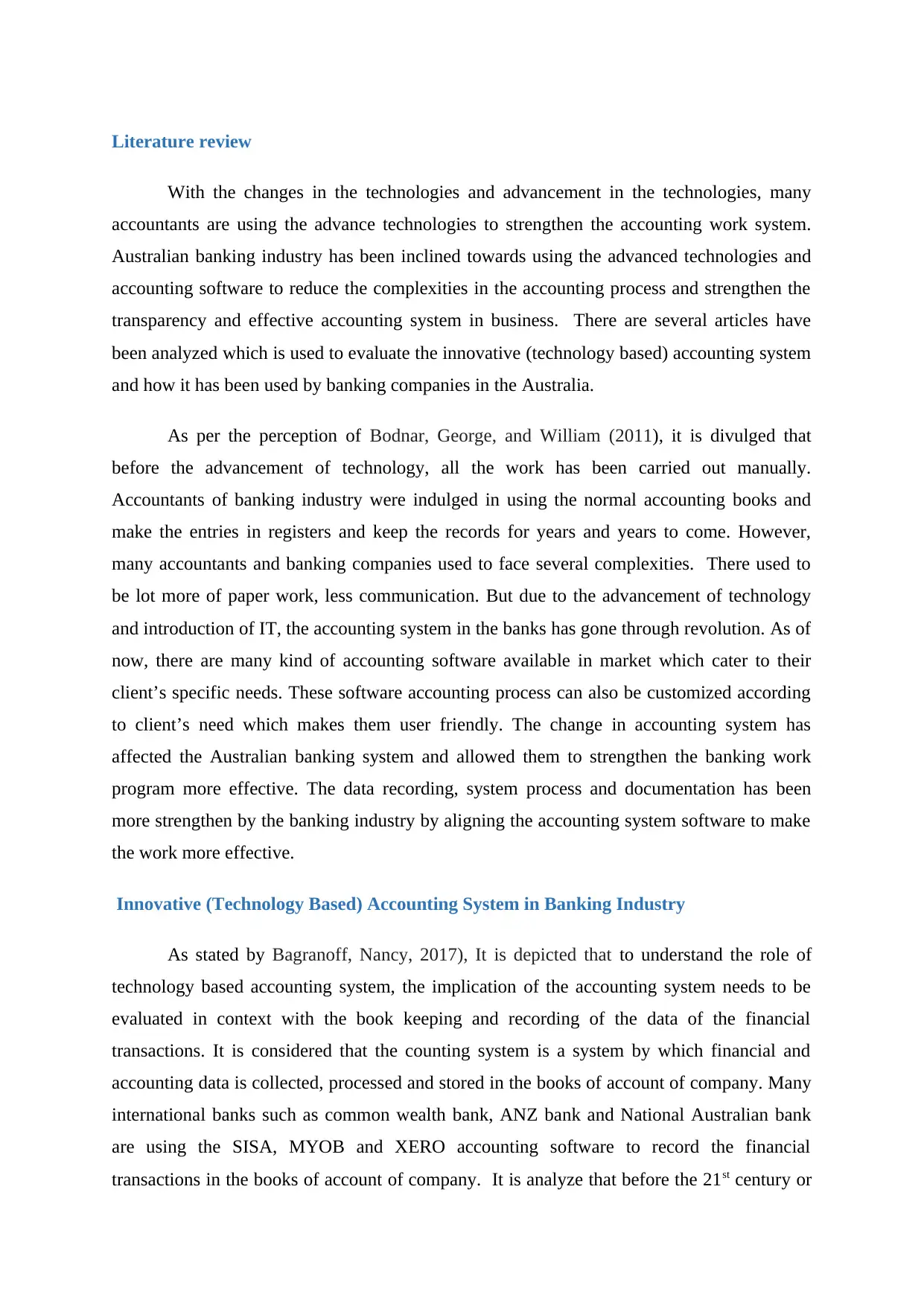
Literature review
With the changes in the technologies and advancement in the technologies, many
accountants are using the advance technologies to strengthen the accounting work system.
Australian banking industry has been inclined towards using the advanced technologies and
accounting software to reduce the complexities in the accounting process and strengthen the
transparency and effective accounting system in business. There are several articles have
been analyzed which is used to evaluate the innovative (technology based) accounting system
and how it has been used by banking companies in the Australia.
As per the perception of Bodnar, George, and William (2011), it is divulged that
before the advancement of technology, all the work has been carried out manually.
Accountants of banking industry were indulged in using the normal accounting books and
make the entries in registers and keep the records for years and years to come. However,
many accountants and banking companies used to face several complexities. There used to
be lot more of paper work, less communication. But due to the advancement of technology
and introduction of IT, the accounting system in the banks has gone through revolution. As of
now, there are many kind of accounting software available in market which cater to their
client’s specific needs. These software accounting process can also be customized according
to client’s need which makes them user friendly. The change in accounting system has
affected the Australian banking system and allowed them to strengthen the banking work
program more effective. The data recording, system process and documentation has been
more strengthen by the banking industry by aligning the accounting system software to make
the work more effective.
Innovative (Technology Based) Accounting System in Banking Industry
As stated by Bagranoff, Nancy, 2017), It is depicted that to understand the role of
technology based accounting system, the implication of the accounting system needs to be
evaluated in context with the book keeping and recording of the data of the financial
transactions. It is considered that the counting system is a system by which financial and
accounting data is collected, processed and stored in the books of account of company. Many
international banks such as common wealth bank, ANZ bank and National Australian bank
are using the SISA, MYOB and XERO accounting software to record the financial
transactions in the books of account of company. It is analyze that before the 21st century or
With the changes in the technologies and advancement in the technologies, many
accountants are using the advance technologies to strengthen the accounting work system.
Australian banking industry has been inclined towards using the advanced technologies and
accounting software to reduce the complexities in the accounting process and strengthen the
transparency and effective accounting system in business. There are several articles have
been analyzed which is used to evaluate the innovative (technology based) accounting system
and how it has been used by banking companies in the Australia.
As per the perception of Bodnar, George, and William (2011), it is divulged that
before the advancement of technology, all the work has been carried out manually.
Accountants of banking industry were indulged in using the normal accounting books and
make the entries in registers and keep the records for years and years to come. However,
many accountants and banking companies used to face several complexities. There used to
be lot more of paper work, less communication. But due to the advancement of technology
and introduction of IT, the accounting system in the banks has gone through revolution. As of
now, there are many kind of accounting software available in market which cater to their
client’s specific needs. These software accounting process can also be customized according
to client’s need which makes them user friendly. The change in accounting system has
affected the Australian banking system and allowed them to strengthen the banking work
program more effective. The data recording, system process and documentation has been
more strengthen by the banking industry by aligning the accounting system software to make
the work more effective.
Innovative (Technology Based) Accounting System in Banking Industry
As stated by Bagranoff, Nancy, 2017), It is depicted that to understand the role of
technology based accounting system, the implication of the accounting system needs to be
evaluated in context with the book keeping and recording of the data of the financial
transactions. It is considered that the counting system is a system by which financial and
accounting data is collected, processed and stored in the books of account of company. Many
international banks such as common wealth bank, ANZ bank and National Australian bank
are using the SISA, MYOB and XERO accounting software to record the financial
transactions in the books of account of company. It is analyze that before the 21st century or
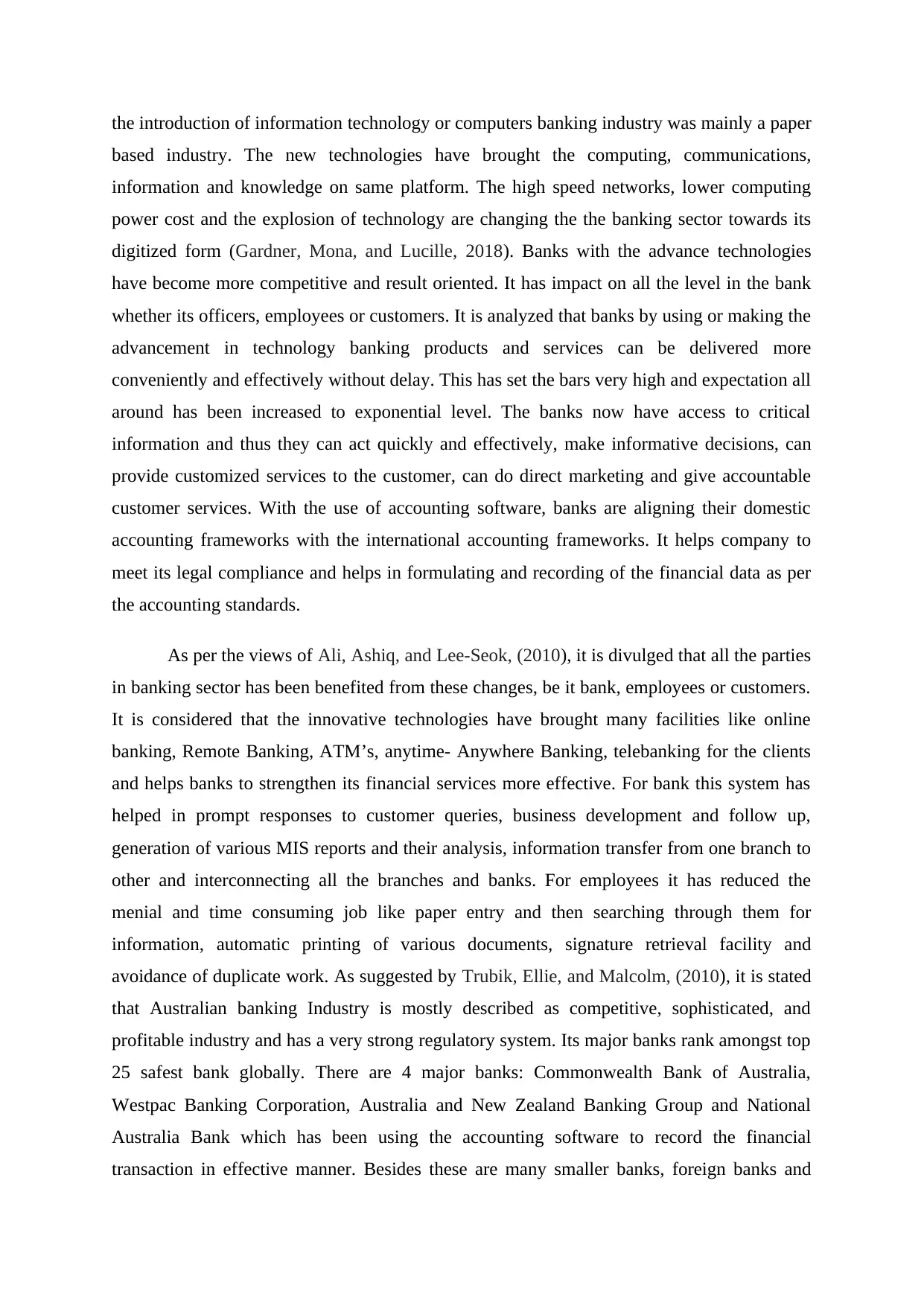
the introduction of information technology or computers banking industry was mainly a paper
based industry. The new technologies have brought the computing, communications,
information and knowledge on same platform. The high speed networks, lower computing
power cost and the explosion of technology are changing the the banking sector towards its
digitized form (Gardner, Mona, and Lucille, 2018). Banks with the advance technologies
have become more competitive and result oriented. It has impact on all the level in the bank
whether its officers, employees or customers. It is analyzed that banks by using or making the
advancement in technology banking products and services can be delivered more
conveniently and effectively without delay. This has set the bars very high and expectation all
around has been increased to exponential level. The banks now have access to critical
information and thus they can act quickly and effectively, make informative decisions, can
provide customized services to the customer, can do direct marketing and give accountable
customer services. With the use of accounting software, banks are aligning their domestic
accounting frameworks with the international accounting frameworks. It helps company to
meet its legal compliance and helps in formulating and recording of the financial data as per
the accounting standards.
As per the views of Ali, Ashiq, and Lee-Seok, (2010), it is divulged that all the parties
in banking sector has been benefited from these changes, be it bank, employees or customers.
It is considered that the innovative technologies have brought many facilities like online
banking, Remote Banking, ATM’s, anytime- Anywhere Banking, telebanking for the clients
and helps banks to strengthen its financial services more effective. For bank this system has
helped in prompt responses to customer queries, business development and follow up,
generation of various MIS reports and their analysis, information transfer from one branch to
other and interconnecting all the branches and banks. For employees it has reduced the
menial and time consuming job like paper entry and then searching through them for
information, automatic printing of various documents, signature retrieval facility and
avoidance of duplicate work. As suggested by Trubik, Ellie, and Malcolm, (2010), it is stated
that Australian banking Industry is mostly described as competitive, sophisticated, and
profitable industry and has a very strong regulatory system. Its major banks rank amongst top
25 safest bank globally. There are 4 major banks: Commonwealth Bank of Australia,
Westpac Banking Corporation, Australia and New Zealand Banking Group and National
Australia Bank which has been using the accounting software to record the financial
transaction in effective manner. Besides these are many smaller banks, foreign banks and
based industry. The new technologies have brought the computing, communications,
information and knowledge on same platform. The high speed networks, lower computing
power cost and the explosion of technology are changing the the banking sector towards its
digitized form (Gardner, Mona, and Lucille, 2018). Banks with the advance technologies
have become more competitive and result oriented. It has impact on all the level in the bank
whether its officers, employees or customers. It is analyzed that banks by using or making the
advancement in technology banking products and services can be delivered more
conveniently and effectively without delay. This has set the bars very high and expectation all
around has been increased to exponential level. The banks now have access to critical
information and thus they can act quickly and effectively, make informative decisions, can
provide customized services to the customer, can do direct marketing and give accountable
customer services. With the use of accounting software, banks are aligning their domestic
accounting frameworks with the international accounting frameworks. It helps company to
meet its legal compliance and helps in formulating and recording of the financial data as per
the accounting standards.
As per the views of Ali, Ashiq, and Lee-Seok, (2010), it is divulged that all the parties
in banking sector has been benefited from these changes, be it bank, employees or customers.
It is considered that the innovative technologies have brought many facilities like online
banking, Remote Banking, ATM’s, anytime- Anywhere Banking, telebanking for the clients
and helps banks to strengthen its financial services more effective. For bank this system has
helped in prompt responses to customer queries, business development and follow up,
generation of various MIS reports and their analysis, information transfer from one branch to
other and interconnecting all the branches and banks. For employees it has reduced the
menial and time consuming job like paper entry and then searching through them for
information, automatic printing of various documents, signature retrieval facility and
avoidance of duplicate work. As suggested by Trubik, Ellie, and Malcolm, (2010), it is stated
that Australian banking Industry is mostly described as competitive, sophisticated, and
profitable industry and has a very strong regulatory system. Its major banks rank amongst top
25 safest bank globally. There are 4 major banks: Commonwealth Bank of Australia,
Westpac Banking Corporation, Australia and New Zealand Banking Group and National
Australia Bank which has been using the accounting software to record the financial
transaction in effective manner. Besides these are many smaller banks, foreign banks and
⊘ This is a preview!⊘
Do you want full access?
Subscribe today to unlock all pages.

Trusted by 1+ million students worldwide
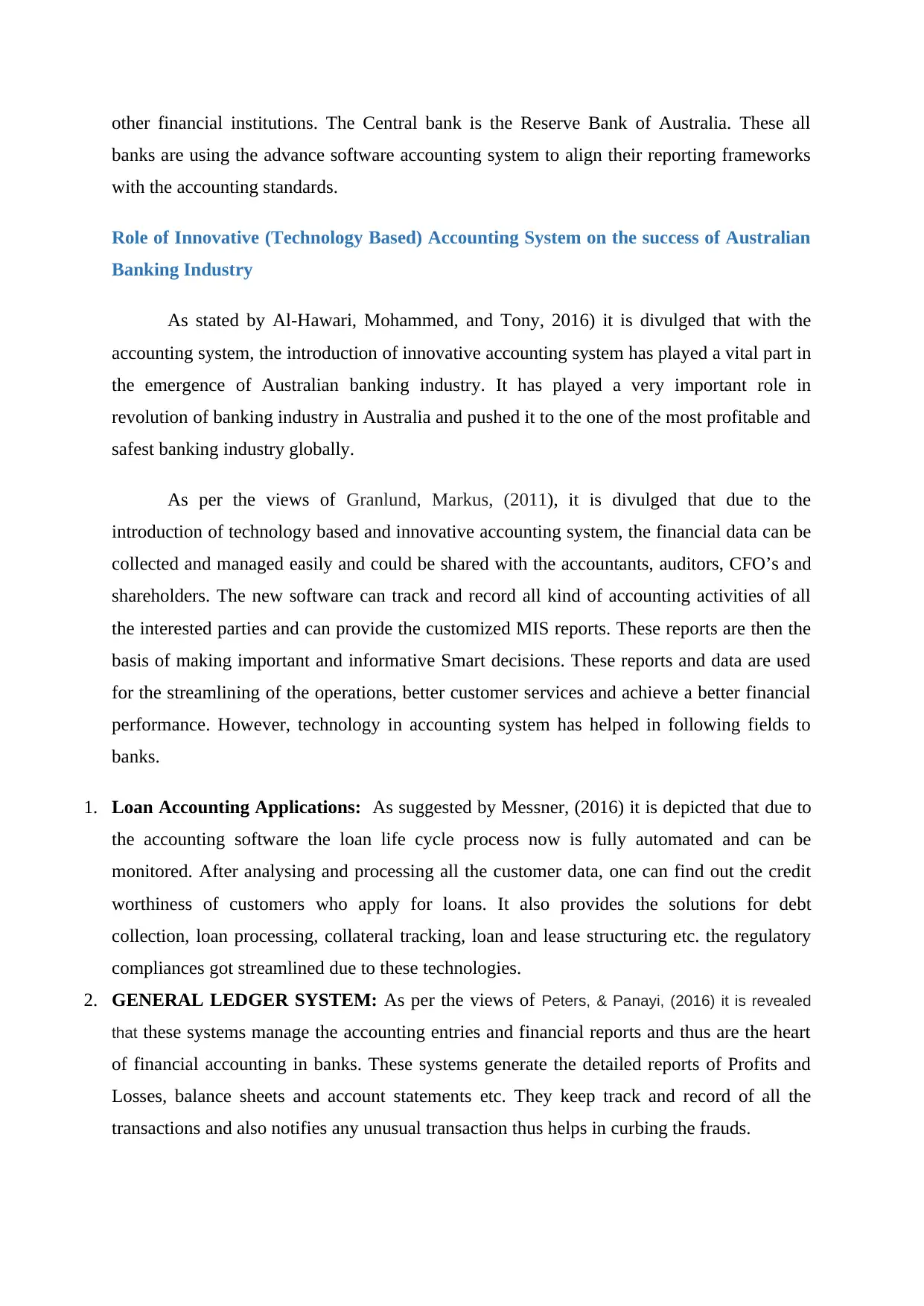
other financial institutions. The Central bank is the Reserve Bank of Australia. These all
banks are using the advance software accounting system to align their reporting frameworks
with the accounting standards.
Role of Innovative (Technology Based) Accounting System on the success of Australian
Banking Industry
As stated by Al-Hawari, Mohammed, and Tony, 2016) it is divulged that with the
accounting system, the introduction of innovative accounting system has played a vital part in
the emergence of Australian banking industry. It has played a very important role in
revolution of banking industry in Australia and pushed it to the one of the most profitable and
safest banking industry globally.
As per the views of Granlund, Markus, (2011), it is divulged that due to the
introduction of technology based and innovative accounting system, the financial data can be
collected and managed easily and could be shared with the accountants, auditors, CFO’s and
shareholders. The new software can track and record all kind of accounting activities of all
the interested parties and can provide the customized MIS reports. These reports are then the
basis of making important and informative Smart decisions. These reports and data are used
for the streamlining of the operations, better customer services and achieve a better financial
performance. However, technology in accounting system has helped in following fields to
banks.
1. Loan Accounting Applications: As suggested by Messner, (2016) it is depicted that due to
the accounting software the loan life cycle process now is fully automated and can be
monitored. After analysing and processing all the customer data, one can find out the credit
worthiness of customers who apply for loans. It also provides the solutions for debt
collection, loan processing, collateral tracking, loan and lease structuring etc. the regulatory
compliances got streamlined due to these technologies.
2. GENERAL LEDGER SYSTEM: As per the views of Peters, & Panayi, (2016) it is revealed
that these systems manage the accounting entries and financial reports and thus are the heart
of financial accounting in banks. These systems generate the detailed reports of Profits and
Losses, balance sheets and account statements etc. They keep track and record of all the
transactions and also notifies any unusual transaction thus helps in curbing the frauds.
banks are using the advance software accounting system to align their reporting frameworks
with the accounting standards.
Role of Innovative (Technology Based) Accounting System on the success of Australian
Banking Industry
As stated by Al-Hawari, Mohammed, and Tony, 2016) it is divulged that with the
accounting system, the introduction of innovative accounting system has played a vital part in
the emergence of Australian banking industry. It has played a very important role in
revolution of banking industry in Australia and pushed it to the one of the most profitable and
safest banking industry globally.
As per the views of Granlund, Markus, (2011), it is divulged that due to the
introduction of technology based and innovative accounting system, the financial data can be
collected and managed easily and could be shared with the accountants, auditors, CFO’s and
shareholders. The new software can track and record all kind of accounting activities of all
the interested parties and can provide the customized MIS reports. These reports are then the
basis of making important and informative Smart decisions. These reports and data are used
for the streamlining of the operations, better customer services and achieve a better financial
performance. However, technology in accounting system has helped in following fields to
banks.
1. Loan Accounting Applications: As suggested by Messner, (2016) it is depicted that due to
the accounting software the loan life cycle process now is fully automated and can be
monitored. After analysing and processing all the customer data, one can find out the credit
worthiness of customers who apply for loans. It also provides the solutions for debt
collection, loan processing, collateral tracking, loan and lease structuring etc. the regulatory
compliances got streamlined due to these technologies.
2. GENERAL LEDGER SYSTEM: As per the views of Peters, & Panayi, (2016) it is revealed
that these systems manage the accounting entries and financial reports and thus are the heart
of financial accounting in banks. These systems generate the detailed reports of Profits and
Losses, balance sheets and account statements etc. They keep track and record of all the
transactions and also notifies any unusual transaction thus helps in curbing the frauds.
Paraphrase This Document
Need a fresh take? Get an instant paraphrase of this document with our AI Paraphraser
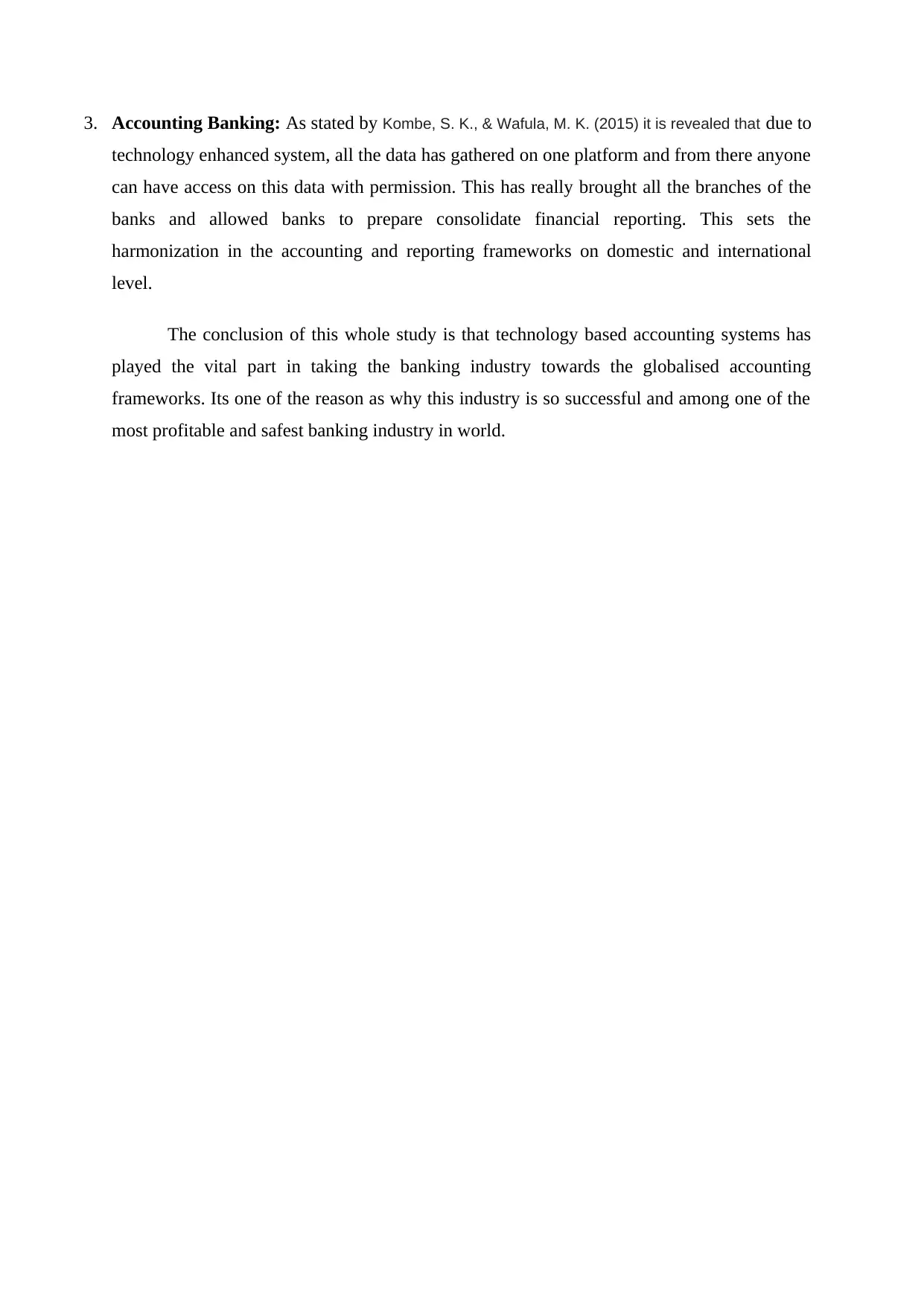
3. Accounting Banking: As stated by Kombe, S. K., & Wafula, M. K. (2015) it is revealed that due to
technology enhanced system, all the data has gathered on one platform and from there anyone
can have access on this data with permission. This has really brought all the branches of the
banks and allowed banks to prepare consolidate financial reporting. This sets the
harmonization in the accounting and reporting frameworks on domestic and international
level.
The conclusion of this whole study is that technology based accounting systems has
played the vital part in taking the banking industry towards the globalised accounting
frameworks. Its one of the reason as why this industry is so successful and among one of the
most profitable and safest banking industry in world.
technology enhanced system, all the data has gathered on one platform and from there anyone
can have access on this data with permission. This has really brought all the branches of the
banks and allowed banks to prepare consolidate financial reporting. This sets the
harmonization in the accounting and reporting frameworks on domestic and international
level.
The conclusion of this whole study is that technology based accounting systems has
played the vital part in taking the banking industry towards the globalised accounting
frameworks. Its one of the reason as why this industry is so successful and among one of the
most profitable and safest banking industry in world.
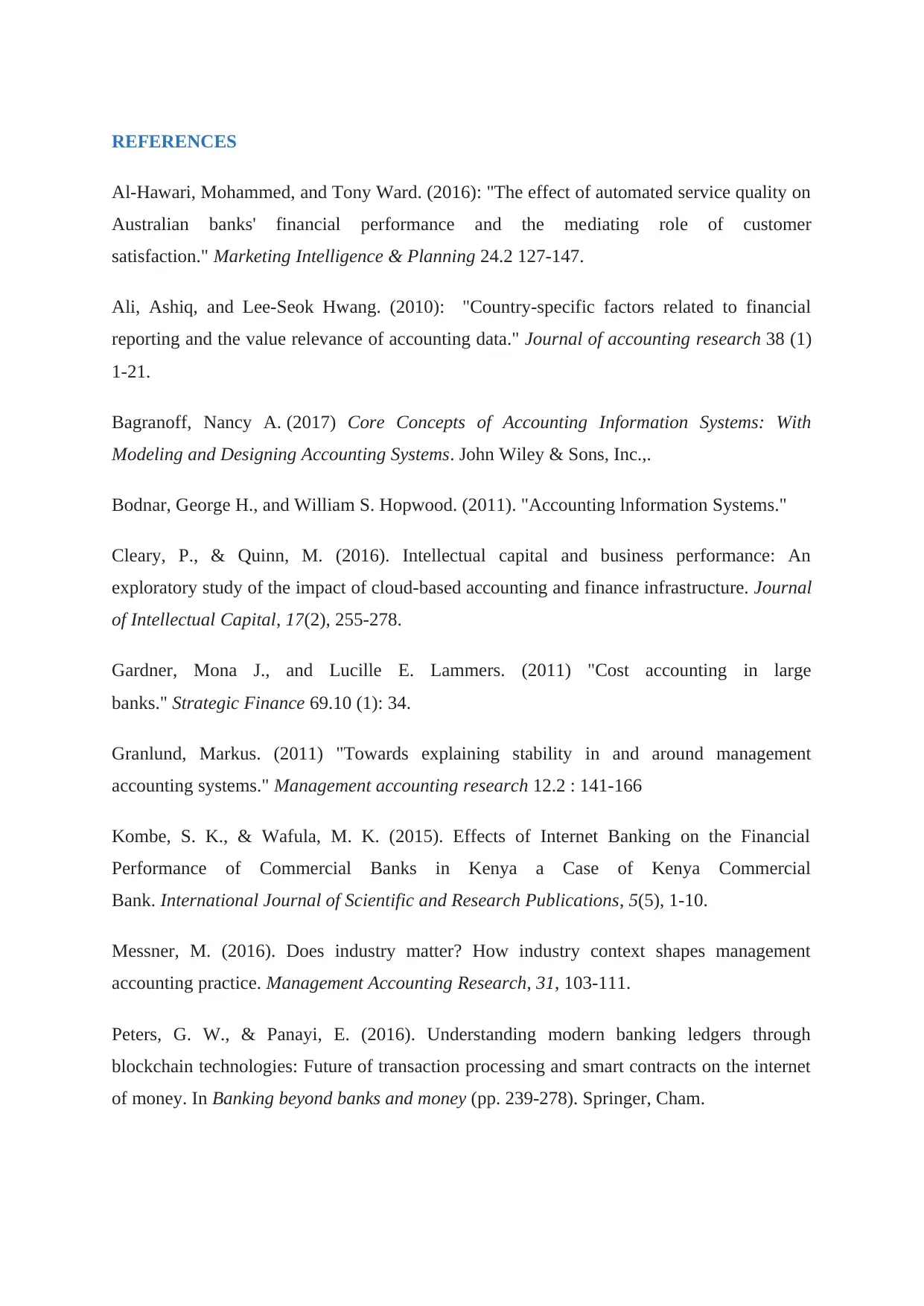
REFERENCES
Al-Hawari, Mohammed, and Tony Ward. (2016): "The effect of automated service quality on
Australian banks' financial performance and the mediating role of customer
satisfaction." Marketing Intelligence & Planning 24.2 127-147.
Ali, Ashiq, and Lee-Seok Hwang. (2010): "Country-specific factors related to financial
reporting and the value relevance of accounting data." Journal of accounting research 38 (1)
1-21.
Bagranoff, Nancy A. (2017) Core Concepts of Accounting Information Systems: With
Modeling and Designing Accounting Systems. John Wiley & Sons, Inc.,.
Bodnar, George H., and William S. Hopwood. (2011). "Accounting lnformation Systems."
Cleary, P., & Quinn, M. (2016). Intellectual capital and business performance: An
exploratory study of the impact of cloud-based accounting and finance infrastructure. Journal
of Intellectual Capital, 17(2), 255-278.
Gardner, Mona J., and Lucille E. Lammers. (2011) "Cost accounting in large
banks." Strategic Finance 69.10 (1): 34.
Granlund, Markus. (2011) "Towards explaining stability in and around management
accounting systems." Management accounting research 12.2 : 141-166
Kombe, S. K., & Wafula, M. K. (2015). Effects of Internet Banking on the Financial
Performance of Commercial Banks in Kenya a Case of Kenya Commercial
Bank. International Journal of Scientific and Research Publications, 5(5), 1-10.
Messner, M. (2016). Does industry matter? How industry context shapes management
accounting practice. Management Accounting Research, 31, 103-111.
Peters, G. W., & Panayi, E. (2016). Understanding modern banking ledgers through
blockchain technologies: Future of transaction processing and smart contracts on the internet
of money. In Banking beyond banks and money (pp. 239-278). Springer, Cham.
Al-Hawari, Mohammed, and Tony Ward. (2016): "The effect of automated service quality on
Australian banks' financial performance and the mediating role of customer
satisfaction." Marketing Intelligence & Planning 24.2 127-147.
Ali, Ashiq, and Lee-Seok Hwang. (2010): "Country-specific factors related to financial
reporting and the value relevance of accounting data." Journal of accounting research 38 (1)
1-21.
Bagranoff, Nancy A. (2017) Core Concepts of Accounting Information Systems: With
Modeling and Designing Accounting Systems. John Wiley & Sons, Inc.,.
Bodnar, George H., and William S. Hopwood. (2011). "Accounting lnformation Systems."
Cleary, P., & Quinn, M. (2016). Intellectual capital and business performance: An
exploratory study of the impact of cloud-based accounting and finance infrastructure. Journal
of Intellectual Capital, 17(2), 255-278.
Gardner, Mona J., and Lucille E. Lammers. (2011) "Cost accounting in large
banks." Strategic Finance 69.10 (1): 34.
Granlund, Markus. (2011) "Towards explaining stability in and around management
accounting systems." Management accounting research 12.2 : 141-166
Kombe, S. K., & Wafula, M. K. (2015). Effects of Internet Banking on the Financial
Performance of Commercial Banks in Kenya a Case of Kenya Commercial
Bank. International Journal of Scientific and Research Publications, 5(5), 1-10.
Messner, M. (2016). Does industry matter? How industry context shapes management
accounting practice. Management Accounting Research, 31, 103-111.
Peters, G. W., & Panayi, E. (2016). Understanding modern banking ledgers through
blockchain technologies: Future of transaction processing and smart contracts on the internet
of money. In Banking beyond banks and money (pp. 239-278). Springer, Cham.
⊘ This is a preview!⊘
Do you want full access?
Subscribe today to unlock all pages.

Trusted by 1+ million students worldwide
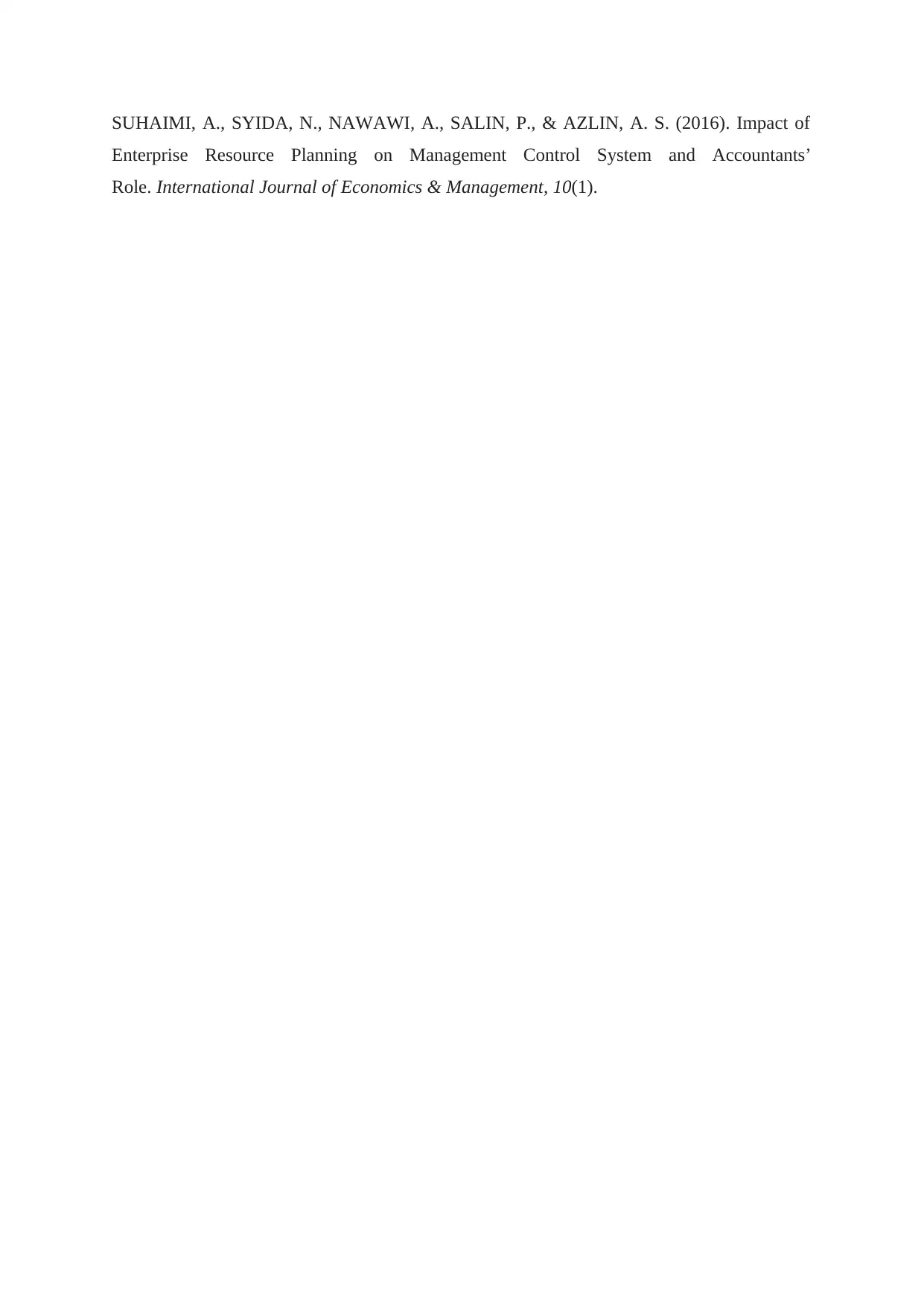
SUHAIMI, A., SYIDA, N., NAWAWI, A., SALIN, P., & AZLIN, A. S. (2016). Impact of
Enterprise Resource Planning on Management Control System and Accountants’
Role. International Journal of Economics & Management, 10(1).
Enterprise Resource Planning on Management Control System and Accountants’
Role. International Journal of Economics & Management, 10(1).
1 out of 7
Related Documents
Your All-in-One AI-Powered Toolkit for Academic Success.
+13062052269
info@desklib.com
Available 24*7 on WhatsApp / Email
![[object Object]](/_next/static/media/star-bottom.7253800d.svg)
Unlock your academic potential
Copyright © 2020–2025 A2Z Services. All Rights Reserved. Developed and managed by ZUCOL.





